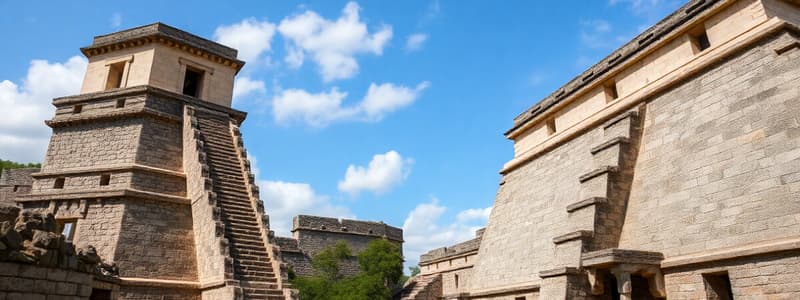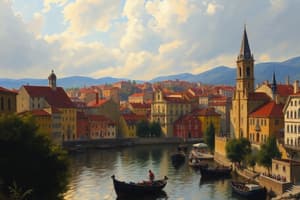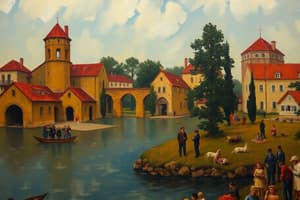Podcast
Questions and Answers
What characterized the transition from the Classic period to the Post-Classic era in the Valley of Mexico?
What characterized the transition from the Classic period to the Post-Classic era in the Valley of Mexico?
- Fragmentation of power among city-states (correct)
- An increase in agricultural practices
- A centralized power under a single state
- A decrease in migration and movement
Which development was significantly evident during the Post-Classic period?
Which development was significantly evident during the Post-Classic period?
- Technological innovation accelerated
- Decline in human sacrifices
- Integration of market systems (correct)
- Decrease in long-distance trade
How was metallurgy used in the Post-Classic period?
How was metallurgy used in the Post-Classic period?
- Its use was completely abandoned
- It was extensively utilized in most tools
- It was primarily for creating currency
- It was limited to jewelry and tools (correct)
What role did human sacrifice play in the Post-Classic era?
What role did human sacrifice play in the Post-Classic era?
What is noted about the historical records from the Post-Classic period?
What is noted about the historical records from the Post-Classic period?
Who led the agricultural Tolteca-Chichimeca into the central valley at the beginning of the tenth century?
Who led the agricultural Tolteca-Chichimeca into the central valley at the beginning of the tenth century?
What significant event occurred after Mixcoatl established his capital at Culhuacan?
What significant event occurred after Mixcoatl established his capital at Culhuacan?
What interpretation of the conquest had scholars questioned regarding the legend of Topiltzin-Quetzalcoatl?
What interpretation of the conquest had scholars questioned regarding the legend of Topiltzin-Quetzalcoatl?
What was a notable characteristic associated with Topiltzin-Quetzalcoatl in the legend?
What was a notable characteristic associated with Topiltzin-Quetzalcoatl in the legend?
What was the significance of the city of Tula, founded by Topiltzin-Quetzalcoatl?
What was the significance of the city of Tula, founded by Topiltzin-Quetzalcoatl?
What played a key role in establishing the power of the Toltecs over the surrounding area?
What played a key role in establishing the power of the Toltecs over the surrounding area?
Which deity was considered the supreme god of the Toltecs?
Which deity was considered the supreme god of the Toltecs?
What was the consequence of Topiltzin accepting the 'medicine' offered by Tezcatlipoca?
What was the consequence of Topiltzin accepting the 'medicine' offered by Tezcatlipoca?
Which of the following statements about Tula is not true?
Which of the following statements about Tula is not true?
What led to the end of Topiltzin-Quetzalcoatl's reign at Tula?
What led to the end of Topiltzin-Quetzalcoatl's reign at Tula?
Flashcards
Post-Classic Period
Post-Classic Period
A period in Mesoamerican history, lasting from around 900 AD to the Spanish conquest, characterized by the rise of new states, increased trade, militarism, and more extensive written records.
Long-distance Trade
Long-distance Trade
A key characteristic of the Post-Classic, where long-distance trading networks linked various regions in Mesoamerica, fostering economic integration.
Human Sacrifice
Human Sacrifice
The practice of offering human sacrifices as a means of appeasing gods and preventing cosmic disasters, becoming increasingly widespread in the Post-Classic period.
Toltecs
Toltecs
Signup and view all the flashcards
Teotihuacan's Role
Teotihuacan's Role
Signup and view all the flashcards
Chichimecs
Chichimecs
Signup and view all the flashcards
Mixcoatl
Mixcoatl
Signup and view all the flashcards
Ce Acatl Topiltzin
Ce Acatl Topiltzin
Signup and view all the flashcards
Tula (Tollan)
Tula (Tollan)
Signup and view all the flashcards
Tula (Tollan)
Tula (Tollan)
Signup and view all the flashcards
Tula
Tula
Signup and view all the flashcards
Tezcatlipoca
Tezcatlipoca
Signup and view all the flashcards
Quetzalcoatl
Quetzalcoatl
Signup and view all the flashcards
Topiltzin
Topiltzin
Signup and view all the flashcards
Toltec Religious Conflict
Toltec Religious Conflict
Signup and view all the flashcards
Study Notes
Post-Classic Mexico
- The Classic period's centralized power, exemplified by Teotihuacan, fragmented in areas north of the Maya region.
- Knowledge of the Valley of Mexico (AD 650-900) is limited, but aggressive city-states like Cholula, Xochicalco, and El Tajín competed but failed to unite.
- The Post-Classic era (AD 900-early 16th century) saw increased long-distance trade and economic integration in Mesoamerica.
- Paquimé/ Casas Grandes in northwest Mexico (linking to the US Southwest) is an example of a long-distance trade center showcasing Mesoamerican cultural elements.
- Technological innovation slowed in the Post-Classic, but military prowess and human sacrifice expanded.
- Military capabilities increased, solidifying warriors' prestige, and human sacrifice became prevalent to prevent cosmic disasters.
- More written records from this period offer greater clarity on individuals and events, although accounts are often mythical and inconsistent.
The Toltecs
- Teotihuacan, a northeastern valley city, acted as a buffer between "civilized" Mexico and northern nomadic groups (Chichimecs).
- The Toltecs, led by Mixcoatl, migrated to the central valley of Mexico in the 10th century.
- Mixcoatl was assassinated, and his son, Topiltzin-Quetzalcoatl, became a cultural figure, known for opposing human sacrifice and being associated with the god Quetzalcoatl.
- Topiltzin-Quetzalcoatl founded Tula (a significant urban center) in AD 968, situated near the obsidian deposits.
- The Toltecs absorbed northern groups, contributing to the urban Mesoamerican characteristics of the region.
- Although their dominance lasted two centuries, the Toltec influence persisted for five hundred years.
- Tula featured impressive architecture, palaces, and elaborate decorations showcasing exotic birds, gold, jewels, and shells.
- Religious conflicts emerged, with factions supporting Tezcatlipoca (associated with obsidian and fate) opposing Quetzalcoatl during Topiltzin's reign.
- Topiltzin-Quetzalcoatl is linked to the legend of leaving cross-like signs and leaving Tula in exile
- Topiltzin's legacy was tied to the belief of his potential return.
The Zapotecs and Mixtecs
- Zapotecs remained influential in Oaxaca, maintaining centers like Zaachila and Mitla, demonstrating sophisticated urban design with intricate geometric stonework.
- Mixtec culture thrived in the mountainous region west/north of Zapotecs; their impressive artistic skill shows up in sophisticated art, adorned with details and colors.
- Mixtecs crafted intricate picture codices, which provide historical accounts.
- Mixtecs embraced metallurgy, especially gold and silver, after around AD 1000.
- Mixtecs absorbed influence from the neighboring Toltecs.
- Mixtecs and Zapotecs played a key role in obsidian trade, creating and exchanging tools.
The Post-Classic Maya
- Yucatán Peninsula witnessed the rise of a distinctive Maya culture around AD 900.
- The peninsula's limestone topography, cenotes, and thin soil influenced agricultural practices in the area.
- Arrival of "foreigners" (including possibly Toltec refugees) significantly shaped the culture of the Yucatec Maya.
- Chichen Itza became a powerful center, embracing both earlier Maya traditions and new influences from elsewhere in Mesoamerica (including possibly Topiltzin-Quetzalcoatl).
- Political and cultural change and decentralization shifted power.
- Environmental factors like drought and warfare also influenced the region.
Studying That Suits You
Use AI to generate personalized quizzes and flashcards to suit your learning preferences.



